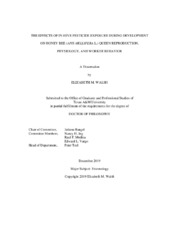| dc.description.abstract | Several factors are responsible for the health decline currently faced by managed honey bees (Apis mellifera) worldwide, including pests, pathogens, queen failure, pesticide contamination, habitat fragmentation and nutritional stress. One of the most important contributors in this decline is the ectoparasitic mite Varroa destructor, a ubiquitous pest that, when found in high numbers, causes colonies to collapse and die. To control Varroa since its introduction three decades ago, beekeepers in the U.S. have treated colonies with the miticides tau-fluvalinate, coumaphos, and amitraz. These pesticides, in addition to forager-collected fungicides and insecticides, such as chlorothalonil and chlorpyrifos, bind to the colony’s lipophilic wax matrix and remain permanently in the hive until the comb is replaced. Most studies exploring the effects of pesticides on honey bee health have focused on oral or topical exposure of workers, often using unrealistically high concentrations of these chemicals. Incidentally, few studies have examined the synergistic and combinatorial effects of exposure to pesticide-laden wax during development on honey bee queen reproductive health. The goal of this dissertation was to determine the effects of wax exposure to pesticides during development on honey bee queen physiology and reproduction, as well as queen and worker behavior. To do this, we reared honey bee queens in beeswax contaminated with field-relevant combinations of the miticides tau-fluvalinate, coumaphos, and amitraz, as well as the pesticides chlorothalonil and chlorpyrifos (or left the wax free of pesticides, as a control). Once adult queens emerged from their cells and mated, we housed them in observation hives to assess worker retinue behavior and queen egg-laying rate. We found that queens reared in pesticide-free wax had significantly larger retinues and higher egg-laying rates than queens reared in any of the pesticide treatment groups. We then dissected the queens’ mandibular glands, which produce pheromones that attract retinue workers and maintain colony organization, to conduct caged worker bioassays and GC-MS analyses. Caged workers were significantly more attracted to the mandibular extracts of queens reared in pesticide-free wax, and these queens produced gland pheromone profiles significantly different from those produced by queens reared in any of the pesticide treatment groups. Using the same experimental treatments, we also measured other markers of queen reproductive health and fitness including the rate at which developing queen larvae were fed by nurse workers, adult queen size and weight, viability of spermatozoa stored in the mated queen’s spermatheca, the number of ovarioles per ovary, and the queen’s mating frequency. We found no significant differences between queens reared in pesticide-free versus pesticide-laden wax for the nurse feeding rate toward developing queens, adult queen size, weight, or ovariole number. Surprisingly, queens reared in wax contaminated with amitraz mated with significantly more drones than queens in any other experimental group, including the controls. Our results show that pesticide exposure during development affects some aspects of queen physiology, including egg-laying rate, mating frequency, and worker retinue behavior, which likely have important fitness implications at the colony level. | en |


